Last updated: July 23, 2025
Article
Increasing caribou leads to expanded ranges and impacts on vegetation

Shifting and expanding ranges of a sub-Arctic caribou herd and associated changes in vegetation
Abstract
Rapid climate warming has contributed to significant changes in Arctic and boreal vegetation over the past half century. Changes in vegetation can impact wildlife by altering habitat and forage availability, which can affect behavior and range use. However, animals can also influence vegetation through foraging and trampling and therefore play an important role in determining ecosystem responses to climate change. As wildlife populations grow, density-dependent processes can prompt range expansion or shifts. One mechanism for this is density-dependent forage reduction, which can contribute to nutritional stress and population declines, and can also alter vegetation change trajectories. We assessed the range characteristics of a migratory caribou (Rangifer tarandus) herd in east-central Alaska and west-central Yukon Territory as it grew (1992–2017) then declined (2017–2020). Furthermore, we analyzed the correlation between caribou relative spatial density and vegetation change over this period using remotely sensed models of plant functional type cover. Over this period, caribou population density increased in all seasonal ranges. This was most acute in the calving range where density increased 8-fold, from 1.5 to 12.0 animals km−2. Concurrent with increasing density, we documented range shifts and expansion across summer, post-calving and winter ranges. In particular, summer range size doubled (12,000 km2 increase) and overlap with core range (areas with repeated year-round use) was halved. Meanwhile, lichen cover, a key forage item, declined more in areas with high caribou density (2.4% absolute, 22% relative decline in cover) compared to areas where caribou were mostly absent (0.3% absolute, 1.9% relative decline). Conversely, deciduous shrub cover increased more in high caribou density areas. However, increases were dominated by less palatable shrubs whereas more palatable shrubs (i.e., willow [Salix spp.]) were stable or declined slightly. These changes in vegetation cover were small relative to uncertainty in the map products used to calculate change. Nonetheless, correlations between vegetation change and caribou range characteristics, along with concerning demographic trends reported over this same period, suggest changing forage conditions may have played a role in the herd's subsequent population decline. Our research highlights the potential of remotely sensed metrics of vegetation change for assessing the impacts of herbivory and trampling and stresses the importance of in situ data such as exclosures for validating such findings.
Orndahl, K. M., T. W. Bentzen, L. T. Berner, L. P. W. Ehlers, M. Hebblewhite, J. D. Herriges, K. Joly, M. J. Macander, E. C. Palm, M. J. Suitor, and S. J. Goetz. 2025. Shifting and expanding ranges of a sub-Arctic caribou herd and associated changes in vegetation. Ecological Applications 35 (4): e70038.
